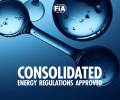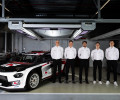THE ROAD TO SAFETY

Q Charlie, here at the conference we’ve heard a lot about the continual push for safety, particularly the high-speed cameras in Formula One. Tell us about some of the work that’s going on?
CW We work very closely with the teams and I have to say they are very co-operative. Whenever we come up with a new idea, it’s always easy to talk about it and get things done very quickly.
We develop all sorts of things, such as the in-ear accelerometers that all the drivers have worn for a couple of years, higher and stronger cockpit sides, standard side impact structures, it’s an ongoing thing.
One of the biggest challenges we will face in the near future will be to provide additional frontal protection in the event of an object coming towards them.
Q Steve, we’ve seen a number of concussions in recent months in motor sport, such as in Fernando Alonso’s testing accident, is that a concern?
SO I’m very concerned about concussion. Ten to 15 years ago we used to say, when a driver walked out of a car, ‘oh, he’s just had a concussion, he’s OK’. Now we know from things that have happened in hockey, soccer and American football that repeated concussions too close together are very detrimental and can cause severe illness.
With kids that are getting into go-karting, one of the problems is a likelihood of concussion. One of the important things we need to learn how to do quickly is get those diagnosed.
We miss a lot of concussions because the symptoms often don’t show up for 24 or 48 hours, so we need to make the diagnosis early and we need to treat the kids appropriately and not let them back into competition too soon, as that causes the repeated insults to the brain and disease later in life.
Q One of the key things recently in NASCAR and in Indycar has been accidents due to cars racing very close together – things that fans find exciting but which carry a high level of danger. What’s your view on that balance between danger and entertainment?
SO I wrestle with that balance myself, because the races are exciting, but they’re more scary than exciting.
I’ve talked to two or three of the Indycar drivers and I understand what they’re saying and I agree with them: if you make the rules so that it bunches everybody up, because the lesser guys, can run with the big boys, this makes a very dangerous situation.
In Fontana, California they were going over 200mph, side by side, and all it takes is one slip-up from one of these drivers who is not as accomplished and that can set off a chain reaction. Then it’s a crapshoot.
All the things that we’ve done become unpredictable. What we do is look at things that are predictable and have happened in the past. We were very lucky in both in Daytona and Fontana this past week that nobody was seriously injured but it could have easily gone the other way.

 Facebook
Facebook Twitter
Twitter






